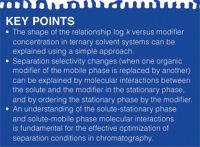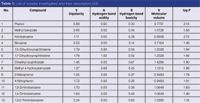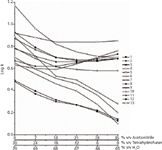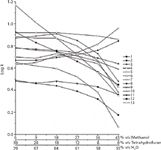Retention and Selectivity of Aromatic Hydrocarbons with Polar Groups in Ternary Reversed-Phase–HPLC Systems with Tetrahydrofuran as Modifier
LCGC Europe
The variation in selectivity of aromatic hydrocarbons with bisubstituted polar groups is investigated in systems consisting of C18 stationary phase and ternary eluents. The solutions of the ternary eluents were obtained by mixing binary solvents (organic modifier + water) of similar eluent strength. Acetonitrile, methanol and tetrahydrofuran were the organic modifiers applied. The influence of the organic solvent type and its concentration in the ternary mobile phase on retention and selectivity of the solutes is discussed. An approach previously presented by our group was adapted to explain the selectivity changes.
The variation in selectivity of aromatic hydrocarbons with bisubstituted polar groups was investigated in systems comprised of a C18 stationary phase and ternary eluents. The ternary eluents were obtained by mixing binary solvents (organic modifier + water) of a similar eluent strength. Acetonitrile, methanol, and tetrahydrofuran were the organic modifiers applied. The influence of the organic solvent type on retention and selectivity of the solutes and its concentration in the ternary mobile phase is discussed. The approach previously presented by our group was adapted to explain the selectivity change.
During the last four decades, reversed-phase liquid chromatography (reversed-phase LC) has evolved into a successful technique. Reversed-phase LC is applied to separate a very wide range of molecules, including charged, polar, and nonpolar, and is controlled with variables such as organic solvent type, concentration, pH, and temperature (1–3). For this reason, researchers invest a lot of effort investigating the mechanism of retention in reversed-phase LC systems (4–6). An understanding of the solute–stationary phase and solute–mobile phase molecular interactions is fundamental for the effective optimization of separation conditions.

Various parameters must be taken into account, including the properties of solvents, and the type of solute and nature of the chemically bonded phase, in order to choose the appropriate separation conditions (7–8). Each of these variables contributes to the retention of substances; for this reason the interpretation and clarification of selectivity changes in various systems is very difficult. Therefore, an approach that simplifies the explanation of changes in selectivity is very desirable. Such an approach has been proposed to explain the changes of separation selectivity of aromatic hydrocarbons with polar groups (9) and phenolic acids (10–11). It assumes that selectivity changes because of the change of modifier in the eluent can be explained by taking into consideration only molecular interactions between the solute and the modifier in the stationary phase (interactions in the mobile phase are neglected), and by ordering the stationary phase by the modifier (9–12).
Binary mobile phases are used in reversed-phase LC, although ternary mobile phases can be used to exploit inimitable chromatographic selectivity (13–16). The ability to obtain the unique selectivity in ternary systems has been described previously (17–19). In 1981 Schoenmakers et al. published the results of a systematic study on ternary solvent behaviour in reversed-phase LC systems (20). The retention of a wide variety of solutes in the ternary systems — methanol + tetrahydrofuran (THF) + water and methanol + acetonitrile + water — was described by a regular but non-linear three-dimensional surface. Schoenmakers et al. then focused on the optimum compositions of ternary mobile-phase mixtures for the separation of samples by reversed-phase LC (21). Numerous groups have proposed theoretical descriptions of retention in linear binary gradient elution chromatography and these descriptions have been subsequently extended to include ternary gradients (22–24). Kowalska proposed a physicochemical model to describe solute retention in reversed-phase LC systems with ternary mobile phases (25), which was additionally refined by assuming the stoichiometric consequences of using acetonitrile or THF (26). Computer-assisted methods were also used to optimize or describe retention in ternary mobile phase systems (27–28). Kiridena and Poole proposed the solvation parameter model to create the system constants for characterization of the mobile and stationary phases in ternary systems (29). Borówko et al. presented more fundamental retention theory using ternary mobile phases (30). Sorption isotherms of ternary eluents in reversed-phase LC was described by Wang et al. (31). The investigation of the effect of ternary mobile phase composition on retention mechanism via the use of van't Hoff equation and linear solvation energy relationship (LSER) methods was presented in Coym's paper (32). Kawabe et al. (33) recently described an optimization procedure of ternary isocratic mobile phase composition in a high performance liquid chromatography (HPLC) method using a prediction model and visualization technique. Despite the passage of years, ternary mobile phase systems are still of great interest to chromatographers.
In this article we applied our approach (9,12) to the interpretation of solute selectivity changes in ternary mobile phase systems. The ternary systems were obtained by mixing the binary water eluents of similar eluent strength. The organic modifiers were methanol, acetonitrile, and THF. Log k values were obtained in ternary systems for aromatic bifunctional solutes. The various solutes show different shapes of log k versus ternary eluent composition. The retention and selectivity changes were interpreted with regard to molecular interactions of the solutes in the stationary phase (composition and structure is varied with concentration of the eluent components). In an earlier paper, the retention of aromatic solutes with one polar group in ternary eluent systems was investigated (34). It is interesting to investigate this kind of relationship for bifunctional solutes, which sometimes show enhancement of the selectivity and retention changes in comparison to solutes with one polar substituent. Relative retention changes of aromatic hydrocarbons with different polar groups that confirm the postulated approach based on the previously published data and recent experiments will be discussed (9–12).
Experimental
An HP 1050 liquid chromatograph (Hewlett-Packard) equipped with a 20 μL sample loop injector (Rheodyne) and variable UV detector operated at 254 nm was used to perform the experiments. A custom-made stainless steel column (10 cm × 4.6 mm) was packed with 5 μm particles of ODS silica gel (C18), carbon content 16 w%, produced by Hanai et al. (35,36). The column was thermostated at 20 °C ± 0.2 °C. The solvents were of analytical- or chromatography-grade; water was bidistilled. All eluents contained 0.1% acetic acid (analytical-grade) for dissociation suppression of acidic compounds and residual silanol groups. The hold-up time was determined by injection of pure water. Solutes were usually of pro-analysis quality and were from various distributors. The solutes and their numbers are listed in Table 1. The values of the molecule size, its dipolarity/polarizability, and the hydrogen-bond basicity of the solutes are also presented in the table. These values are useful for interpretation of the observed relative retention change without the introduction of further intermolecular interactions that are known to be extremely weak in solution.

Table 1: List of solutes investigated and their descriptors (43).
Results and Discussion
Tetrahydrofuran + Acetonitrile + Water System: The data presented in Figure 1 demonstrate the log k (k is the retention factor) dependence on ternary eluent composition. The solutions of the ternary eluent were obtained by mixing binary water solutions of similar eluent strength. In Figure 1 log k of the solutes are plotted against the components of the ternary mobile phase (acetonitrile + THF + water). A solution of 30 v% THF in water and 35 v% acetonitrile in water were mixed in various ratios to obtain the mobile phase in the concentration ranges 0–30 v% and 0–35 v% of THF and acetonitrile, respectively. The relationships for aromatic hydrocarbons with two polar groups and three nitro groups (1,3,5-trinitrobnzene) are presented. Benzene and phenol are also presented to explain the relative retention changes of the solutes investigated. Retention of phenol increased fairly regularly with THF concentration. This can be explained by the increased participation of the specific (hydrogen bond) molecular interactions of phenol and THF contained in the stationary phase. For other derivatives, some characteristic retention differences relative to phenol are obtained. The plot line of methyl 4-hydroxybenzoate was very similar to that of phenol but both are crossed at 21 v% acetonitrile and 12 v% THF.

Figure 1: Log k for aromatic hydrocarbons with polar group against acetonitrile and tetrahydrofuran concentration in ternary eluent, legends in Table 1.
The retention values of methyl 4-hydroxybenzoate were higher than that of phenol at the lower THF concentration and lower at a higher THF concentration. The lower angle of the slope of the ester derivative line in comparison with that of phenol can be explained by the different structure of these molecules. The molecule of methyl 4-hydroxybenzoate has more branches and is larger than the phenol molecule (Table 1). This in turn leads to a decrease in its ability to penetrate the stationary phase region, especially the higher THF concentration (higher degree of stationary phase ordering). In addition, the molecule of ester derivative is longer than the phenol molecule, which means the specific molecular interaction of the ester molecule with THF in the ordered stationary phase was more strongly restricted.
On the other hand, methyl 4-hydroxybenzoate possessed a higher value of dipole moment than phenol (Table 1) that could enhance its interactions with acetonitrile relative to THF in the stationary phase. Although acetonitrile and THF possess a similar ability according to the values of solvatochromic parameters (37), the electric dipole moment of the acetonitrile was almost two times greater than that of THF (3.45 D and 1.75 D for acetonitrile and THF, respectively) (38).
The relationship for 4-nitrophenol showed a greater gradient than that for methyl 4-hydroxybenzoate and phenol with an increase of THF concentration. The 4-nitrophenol molecule differed relative to 4-hydroxybenzoate and phenol with regard to the proton-donor ability. The proton-donor property of the former solute was higher than that of phenol and methyl 4-hydroxybenzoate (Table 1). The 4-nitrophenol molecule formed stronger H-bonding with the THF contained in the stationary phase region. In addition, the solute had a planar structure stabilized by mezomeric effect that enhanced its ability to penetrate the stationary phase region with THF rather than acetonitrile. The nitro group in the solute molecule also enhanced its retention in THF systems relative to other modifier systems. Relative retention increase of the nitro derivative in the THF system in comparison to acetonitrile can be explained in a similar way as was demonstrated for aromatic (9) and aliphatic (39) hydrocarbon derivatives with nitro group/s. The nitro group formed quadrupole. Two bonds between nitrogen and oxygen atoms in the nitro group are highly polarized with an electron density deficiency on the nitrogen atom. The THF molecule has two C–O bonds (ether group), which were polarized with the higher electron density on the oxygen atom, and in this way formed quadrupole too. Both quadrupoles (nitro and ether groups) matched each other, which led to strong electrostatic interactions between 4-nitrophenol and THF. These properties can be responsible for a higher slope of the relationship log k versus ternary eluent composition (acetonitrile + THF + water), with an increase of THF concentration relative to that of phenol and methyl 4-hydroxybenzoate.
The effect of nitro groups can also be seen when the retention change of nitrobenzene, 1,2-dinitrobenzene, 1,4-dinitrobenzene, and 1,3,5-trinitrobenzene was compared. In binary system acetonitrile + H2O the retention of these solutes was comparable. This has been reported previously (9).
When the concentration of THF in the ternary mobile phase increased, the retention of these solutes increased according to the number of nitro groups in the molecule. It is further evidence that molecular quadrupole interactions of the nitrobenzenes and THF in the stationary phase region are responsible for such an effect. This is contrary to the expectations based on the solvophobic expulsion of the solute from the aqueous mobile phase. In this case the solute series should be eluted in reverse order because of the effect of the hydrophilic properties of the nitro group. This is confirmed by retention data of these solutes in a system with C18 stationary phase and methanol + water mobile phase (9). In the methanol system, the retention order of these solutes was reversed relative to the THF system.
1,4-dinitrobenzene and 1,2-dinitrobenzene demonstrated a very similar relationship and practically no retention change in the range 0–12 v% THF. Both solutes showed a retention increase for higher THF concentrations but the retention of 1,4-dinitrobenzene increased slightly more. It seems reasonable to explain the effect with regard to the solute molecular interactions in the stationary phase too. The lack of a retention increase at a low concentration of THF was caused by a relatively small concentration of THF in the stationary phase, which is not yet strongly solvated by THF. In the higher concentration range the ordering of the stationary phase was stronger, which caused a lower retention increase of the 1,2-dinitrobenzene because of its no planar structure, in contrast to 1,4-dinitrobenzene, which is a planar structure. It is worth comparing the retention changes of 4-nitrophenol and 1,4-dinitrobenzene. In the acetonitrile + H2O system, the separation factor of these solutes α4-nitrophenol/1,4-dinitrobenzene is 0.39 and increases to 0.91 when the THF concentration reaches 30 v%. Retention of 4-nitrophenol therefore increased relative to 1,4-dinitrobenzene, with an increase of THF concentration in the ternary mobile phase. 4-nitrophenol showed a stronger ability to bond hydrogen with THF than 1,4-dinitrobenzene (hydrogen bond acidity is equal to 0.82 and 0.00, respectively, for 4-nitrophenol and 1,4-dinitrobenzene). This effect was not visible when separation selectivity of 1,2-dinitrobenzene/2-nitrophenol was compared. The separation factor values for these solutes are about 1.2 in the whole range of modifier concentration of the ternary eluent system. The hydrogen bond acidity value of 2-nitrophenol was equal to 0.05 and its molecular interactions with THF in the stationary phase were weaker than 4–nitrophenol. This is the effect of internal H-bond formation between nitro and hydroxy (phenol) groups.
Increased retention of molecules with one proton donor group relative to the solute without this group can be observed in the systems with THF in comparison to that with acetonitrile. Therefore, the slope of the former solute type (phenol) was higher than that of the later type (benzene). It is evident that phenol shows a stronger ability to act as a hydrogen bond donor than benzene. Similar effects can be observed for methyl 4-hydroxybenzoate relative to methyl benzoate. Two proton donor groups in a solute molecule may increase the probability of specific interactions with THF in the stationary phase, making the considered effect stronger. In fact, the retention increase of dihydroxynaphthalenes in reference to that of monophenol and benzene with an increase of THF concentration in the stationary phase can be observed. This effect was also confirmed by the hydrogen bond acidity of the solutes (Table 1).
A remarkable effect was observed with regard to the selectivity changes of both dihydroxynaphthalenes. The α1,7-dihydroxynaphthalene/1,5-dihydroxynaphthalene value was higher for a smaller THF concentration than for a larger value. This means that higher selectivity of the solutes was observed for a binary acetonitrile system than for a binary tetrahydrofuran system. It also means that steepness of the slope of the 1,5-dihydroxynaphthalene plot was higher than that of 1,7-dihydroxynaphthalene. The effect can probably be explained by different participation of the solute -OH groups to specific interaction in the stationary phase with THF. Simultaneous H-bond formation with two THF molecules was possible for 1,5-dihydroxynaphthalene, but for 1,7-dihydroxynaphthalene two hydroxy groups were much closer and this kind of molecular interaction was less probable, particularly in the ordered stationary phase.
Tetrahydrofuran + Methanol + Water System: In Figure 2 log k values are plotted against the composition of ternary eluent (methanol + tetrahydrofuran + water). The variation of each component concentration was obtained by mixing two binary solutions of 45 v% methanol in water and 30 v% tetrahydrofuran in water. It should be mentioned that the stationary phase ordering by THF for the methanol + tetrahydrofuran system was reached at its lower concentration in the mobile phase in comparison to the THF + acetonitrile system.

Figure 2: Log k for aromatic hydrocarbons with polar group against methanol and tetrahydrofuran concentration in ternary eluent, legends in Table 1.
With this in mind, the selectivity effects concerned with stationary phase ordering by THF extraction was more distinct for a lower tetrahydrofuran concentration than for the acetonitrile + THF system (41). It can be observed that solute retention of more branched molecules relative to that of smaller and flatter molecules (methyl 4-hydroxybenzoate relative to phenol, methyl benzoate relative to benzene, or dimethyl isophtalate relative to methyl benzoate) increased more steeply at lower THF concentrations. The solute retention of branched molecules slightly decreased in the 18–30 v% concentration range of THF. The stationary phase became highly ordered and its entropic penetration by the ester derivatives was more strongly restricted at lower THF concentrations.
The relationship of nitrobenzene was similar to that presented above, but it should be noted the course of the dependence lines for substances with nitrogroups. As discussed earlier, for the THF + acetonitrile + H2O system, the retention of these solutes increased with a rise of THF concentration in the mobile phase of the THF + methanol + H2O system. However, the slope of the lines was steeper for the later system than for the former one. The influence of methanol on the nitro derivative retention in the ternary system was not as strong as that of acetonitrile because of the low extraction of methanol into the stationary phase and its weaker dipolar properties in comparison to acetonitrile.
The relative retention change of biphenols (1,5-dihydroxynaphthalene and 1,7-dihydroxynaphthalene) relative to monophenols increased in the lower concentration range of THF. It is clear that this effect is concerned with two hydroxy groups. The slope of these solute plots was steeper than that of monophenols. However, the solute retention increased less steeply at a higher THF concentration than at a lower concentration. This is probably a result of minor changes of THF content in the stationary phase surface for the range of higher THF concentrations in the eluent (40). However, contrary to the THF-acetonitrile system, the retention change of 1,7-dihydroxynaphthalene differed relative to that of 1,5-dihydroxynaphthalene at a higher THF concentration. At this range even a minor retention decrease of the former could be observed. It appears that 1,7-derivative has a lower probability of simultaneously forming H-bonds with two THF molecules in the ordered stationary phase than the 1,5-derivative, particularly at this concentration range.
On the other hand, the proximity of two hydroxyl groups in 1,7-dihydroxynaphthalene was more favourable to the formation of solvated species of this molecule with self-associated methanol molecules and/or methanol–water complexes in the stationary phase region in the system than that of the 1,5-dihydroxynaphthalene molecule (42). For the latter molecule, embedding with one –OH group in the stationary phase and with the second –OH group in the mobile phase was also probable (9). The H-bond formation between phenols and methanol in the stationary phase of the THF + methanol system was responsible for the less steep slope presented in Figure 2, in comparison to those presented in Figure 1 (acetonitrile + THF system).
Conclusions
The shape of the relationship log k versus modifier concentration in ternary solvent systems comprised of THF, methanol, and water, or THF, acetonitrile, and water can be explained using an approach that states that the interpretation of separation selectivity changes could be considered in terms of molecular interactions in the stationary phase when one organic modifier of the mobile phase is replaced by another. This can be particularly demonstrated by taking into account molecular interactions between solute and modifier in the stationary phase and the ordering of the stationary phase, which depends on the type of eluent modifier. Therefore, molecular interactions of the solutes in the mobile phase could be neglected.
Anna Klimek-Turek is an assistant professor at the Medical University of Lublin, Poland. Her research interests include retention mechanism and solvent selectivity in reversed-phase and normal-phase LC and optimization of the separation of biologically active compounds by LC.
Tomasz Kossowski holds a masters in Pharmacy and a masters in Business Administration. He is also a university teacher, and an experienced sales manager and trainer. He has over 20 years of experience working for global healthcare companies including AkzoNobel-Organon, AstraZeneca, Eli Lilly, General Electric, and BOWA-International. He was recently employed as an engagement manager at The Medicines Company.
Beata Misiolek is a chemistry graduate from Maria Curie Sklodowska University in Lublin, Poland. In 2010 she began her doctoral studies at the Faculty of Pharmacy at the Medical University of Lublin. Her research is currently focused on the mechanisms of the separation selectivity of substances in reversed-phase HPLC.
Tadeusz H. Dzido is the head of the Department of Physical Chemistry at the Medical University of Lublin, Lublin, Poland. His research interests include retention mechanism and solvent selectivity in LC and electrochromatography systems; optimization of the separation of biologically active compounds with LC and electrochromatography techniques; development of equipment for pressurized planar electrochromatography (PPEC); and two-dimensional LC and electrophoresis/electrochromatography performed simultaneously.
References
(1) L. Nasuto, R. Kwietniewski, and J.K. Rózylo, J Chromatogr. A 762 (1–2), 27–33 (1997).
(2) H. Schlüter, J. Chromatogr. Libr. 61, 147–234 (1999).
(3) S. Han, C. Liang, K. Zou, J. Qiao, H. Lian, and X. Ge, Talanta 101, 64–70 (2012).
(4) R. Kaliszan, M.A. Straten, M. Markuszewski, C.A. Cramers, and H.A. Claessens, J. Chromatogr. A 855(2), 455–486 (1999).
(5) P. Staszczuk, K. Albert, B. Pfleiderer, and E. Bayer, J. Chromatogr. A 499, 305–316 (1990).
(6) R.K. Lindsey, J.L. Rafferty, B.L. Eggimann, J.I. Siepmann, and M.R. Schure, J. Chromatogr. A 1287, 60–82 (2013).
(7) U.D. Neue, J.E. O'Gara, and A. Méndez, J. Chromatogr. A 1127(1–2), 161–174 (2006).
(8) L. Limsavarn and J.G. Dorsey, J. Chromatogr. A 1102(1–2), 143–153 (2006).
(9) T.H. Dzido, T.E. Kossowski, and D. Matosiuk, J. Chromatogr. A 947(2), 167–183 (2002).
(10) A. Klimek-Turek and T.H. Dzido, Adsorption 16(4–5), 287–294 (2010).
(11) A. Klimek-Turek, T.H. Dzido, and H. Engelhardt, LCGC Europe 21(1), 33–42 (2008).
(12) T.H. Dzido, J. Liq. Chrom. & Rel. Technol. 23(18), 2773–2788 (2000).
(13) K. Rissler, Chromatographia 51(11–12), 656–668 (2000).
(14) E. Roggendorf and R. Spatz, J. Chromatogr. A 204, 263–268 (1981).
(15) P. Jandera and B. Prokes, J. Liq. Chromatogr. A 14(16–17), 3125–3151 (1991).
(16) J.L. Edwards, R.L. Edwards, K.R. Reid, and R.T. Kennedy, J. Chromatogr. A 1172(2), 127–134 (2007).
(17) N. Tanaka, H. Goodell, and B.L. Karger, J. Chromatogr. A 158, 233–248 (1978).
(18) J.L. Glajch, J.J. Kirkland, K.M. Squire, and J.M. Minor, J. Chromatogr. A 199, 57–79 (1980).
(19) P. Jandera, J. Chromatogr. A 352, 111–126 (1986).
(20) P.J. Schoenmakers, H.A.H. Billiet, and L. De Galen, J. Chromatogr. A 218, 261–284 (1981).
(21) P.J. Schoenmakers, A.C.J.H. Drouen, H.A.H. Billiet, and L. De Galen, Chromatographia 15(11), 688–696 (1982).
(22) P. Jandera, L. Petranek, and M.J. Kucerov, Chromatogr. A 791(1–2), 1–19 (1997).
(23) P. Jandera, J. Churacek, and H. Colin, J. Chromatogr. A 214(1), 35–46 (1981).
(24) J.J. Kirkland and J.L. Glajch, J. Chromatogr. A 255, 27–39 (1983).
(25) T. Kowalska, Chromatographia 28(7–8), 354–358 (1989).
(26) T. Kowalska, Chromatographia 29(7–8), 389–394 (1990).
(27) S. Heinisch, P. Riviere, and J.L. Rocca, Chromatographia 39(3–4), 216–223 (1994).
(28) M.R. Euerby, F. Scannapieco, H.J. Rieger, and I. Molnar, J. Chromatogr. A 1121(2), 219–227 (2006).
(29) W. Kiridena and C.F. Poole, Chromatographia 48(9–10), 607–614 (1998).
(30) M. Borowko, B. Oscik-Mendyk, and P. Borowko, J. Phys. Chem. B 109(44), 21056–62 (2005).
(31) M. Wang, J. Mallette and J.F. Parcher, Anal. Chem. 81(3), 984–990 (2009).
(32) J. Coym, J. Chromatogr. A 1217(38), 5957–5964 (2010).
(33) T. Kawabe, T. Tomitsuka, T. Kajiro, N. Kishi, and T. Toyo'oka, J. Chromatogr. A 1273, 95–104 (2012).
(34) T.H. Dzido and H. Engelhardt, Chromatographia 39(1–2), 67–70 (1994).
(35) M. Ohhira, F. Ohmura, and T. Hanai, J. Liq. Chromatogr. Relat. Technol. 12(6), 1065–1074 (1989).
(36) T. Hanai, M. Ohhira, and T. Tamura, LCGC 6(10), 922–928 (1988).
(37) A. Juan, G. Fonrodona, and E. Casassas, Trends Anal. Chem. 16(1), 52–62 (1997).
(38) Y.A. Karapetian and W.N. Eichis, Physical Chemistry Properties of Electrolytes in Non-Aqueous Solutions (Khimia, Moscow, Russia, 1989).
(39) A. Klimek-Turek, B. Misiolek, and T.H. Dzido, Chromatographia 76(15–16), 939–946 (2013).
(40) M. McCormick and B.L. Karger, Anal. Chem. 52(14), 2249–2257 (1980).
(41) S. Bocian, A. Felinger, and B. Buszewski, Chromatographia supplement 68(1), 19–26 (2008).
(42) M.K. Alamand and J.B. Callis, Anal. Chem. 66(14), 2293–2301 (1994).

Understanding FDA Recommendations for N-Nitrosamine Impurity Levels
April 17th 2025We spoke with Josh Hoerner, general manager of Purisys, which specializes in a small volume custom synthesis and specialized controlled substance manufacturing, to gain his perspective on FDA’s recommendations for acceptable intake limits for N-nitrosamine impurities.










